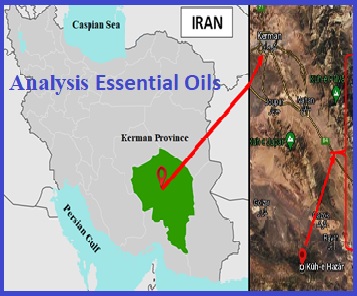Chemical analysis of essential oils of Thymus Carmanicus Jalas by gas chromatography-mass spectrometry and toxicity activity agains t the major Iranian malaria vector, Anopheles Stephensi
Volume 6, Issue 01, Pages 69-78, March 2023 *** Field: Environmental Chemistry Method
Abstract
In the last few years, using chemical insecticides to control the malaria vector has caused environmental pollution and resistance to chemical insecticides. This study aimed to investigate the chemical analysis of essential oils of Thymus carmanicus Jalas by gas chromatography and mass spectrometry (GC-MS) and toxicity activity against the major Iranian malaria vector, Anopheles stephensi. The essential oil of Thymus carmanicus Jalas was prepared from dried leaves using the hydro-distillation method. Gaschromatography-mass spectrometer (GC-MS) was used to analyze and identify thyme essential oil compounds. Bioassay was performed using World Health Organization (WHO) standard test. The T. Carmanicus Jalas essential oil consisted of 15 compounds, with Carvacrol (61%), Thymol (6%), and β-caryophyllene (5%) being the major components by volume. The LC50 and LC90 of thyme oil were 20.37 and 41.38 ppm at 24h after application, respectively. At 24h after application, significant differences were observed between the toxicity of 5%, 20%, 25%, 40%, 50%, and 80% concentrations of Thyme essential oil (P<0.05). The 80% concentration of Thyme essential oil exhibited 100% toxicity against A.stephensi larvae at 24h after application. T. Carmanicus has a rich source of bioactive compounds for use as a mosquito larvicide.
References
M. Thellier, F. Simard, L. Musset, M. Cot, G. Velut, Kendjo E, et al, Changes in malaria epidemiology in France and worldwide, 2000–2015, Med. Mal. Infect., 50 (2020) 99-112. https://doi.org/10.1016/j.medmal.2019.06.002
G. Benelli, J. Beier, Current vector control challenges in the fight against malaria, Acta .Trop., 174 (2017) 91-96. https://doi.org/10.1016/j.actatropica.2017.06.028.
S. Azari-Hamidian, B. Norouzi, R. Harbach, A detailed review of the mosquitoes (Diptera: Culicidae) of Iran and their medical and veterinary importance, Acta. Trop., 1 (2019) 106-122. https://doi.org/10.1016/j.actatropica.2019.03.019.
M. Ahmad, V. Hassan, O. Ali, Reza AM, Anopheline mosquitoes and their role for malaria transmission in an endemic area, southern Iran, Asian Pac. J. Trop. Dis., 1 (2011) 209-211. https://doi.org/10.1016/S2222-1808(11)60030-3
B. Fazeli-Nasab, M. Solouki, A. Sobhanizadeh, Green Synthesis of Silver Nanoparticles Using an Ephedra sinica Herb Extract with Antibacterial Properties, J. Med. Bacteriol., 10 (2021) 30-47. https://jmb.tums.ac.ir/index.php/jmb/article/view/434
M. Khanavi, H. Vatandoost, N. Dehaghi, A. Dehkordi, M. Sedaghat, A. Hadjiakhoondi, Larvicidal activities of some Iranian native plants against the main malaria vector, Anopheles stephensi, Acta. Med. Iran, 15 (2013) 141-147. https://acta.tums.ac.ir/index.php/acta/article/view/4474
M. Soleimani-Ahmadi, M. Gorouhi, A. Mohammadi, Y. SalimAbadi, A. Paksa, G. Rashid, Larvicidial Effects of essential oil and methanol extract of Achilleawilhelmsii C. Koch (Asteraceae) against Anopheles stephensi Liston (Diptera: Culicidae), a malaria vector, J. Kerman Uni. Med. Sci., 24 (2017) 58-67. https://jkmu.kmu.ac.ir/article_42498_76c1b6a54dac8f6df8c3288168c19e7d.pdf
S. Fan, J. Chang, Y. Zong, G. Hu, J. Jia, GC-MS analysis of the composition of the essential oil from Dendranthema indicum Var. Aromaticum using three extraction methods and two columns, Molecules, 23 (2018) 1-11. https://doi.org/10.3390/molecules23030576.
S. Safai L, H. Zeinali, M. Mirza, Study on essential oil content and composition of Thymus caramanicus Jalas in different harvesting stages, Iran. J. Med. Aromatic Plants Res., 29 (2013) 313-324. https://doi.org/10.22092/IJMAPR.2013.2858
M. MakizadehTafti, H. Naghdibadi, S. Rezazadeh, Y. Ajani, Z. Kadkhoda, Evaluation of botanical characteristics and yield and essential components of Thymus carmanicusJalasin Iran, J. Med. Plants., 9 (2010) 57-65. https://doi.org/20.1001.1.2717204.2010.9.36.6.8.
B. Bahreininejad, J. Razmjoo, M. Mirza, Effect of water stress on productivity and essential oil content and composition of Thymus carmanicus, J. Essent. Oil-Bear. Plants., 17(2014) 717-725. https://doi.org/10.1080/0972060X.2014.901605
M. Tafti, H. Badi, S. Rezazadeh, Y. Ajani, Z. Kadkhoda, Evaluation of botanical traits and oil content/chemical composition in Iranian Thymus carmanicus Jalas ecotypes, J. Med. Plant. Res., 9 (2010) 57-212. http://jmp.ir/article-1-246-en.html
M. Bigdeloo, J. Hadian, V. Nazeri, Composition of essential oil compounds from different populations of Thymus caramanicus Jalas, J. Appl. Res. Med. Aromat. Plants, 7 (2017) 95-98. https://doi.org/10.1016/j.jarmap.2017.06.005
J. Hadian, M. Bigdeloo, V. Nazeri, A. Khadivi-Khub, Assessment of genetic and chemical variability in Thymus caramanicus, Mol. Biol. Rep., 41 (2014) 3201-3210. https://doi.org/10.1007/s11033-014-3180-z
P. Ghasemi, M. Barani, B. Hamedi, K. Ataei, A. Karimi, Environment effect on diversity in quality and quantity of essential oil of different wild populations of Kerman thyme, Genetika,45 (2013) 441-450. https://doi.org/10.2298/GENSR1302441P
M. Akhgar, M. Moradalizadeh, A. Faghihi -Zarandi, P. Rajaei, Chemical composition of the essential oils of Ferula oopoda (Boiss. & Buhse) Boiss. and Ferula badghysi (Korovin.) from Iran, J. Essent. Oil-Bear. Plants., 14 (2011) 297-301. https://doi.org/10.1080/0972060X.2011.10643937
T. He, X. Li, X. Wang, X. Xu, X. Yan, X. Li, X. Liu, Chemical composition and anti-oxidant potential on essential oils of Thymus quinquecostatus Celak. from Loess Plateau in China, regulating Nrf2/Keap1 signaling pathway in zebrafish, Sci. Rep., 10 (2020) 1-18. https://doi.org/10.1038/s41598-020-68188-8
M. Hudaib, E. Speroni, A. Di Pietra, V. Cavrini, GC/MS evaluation of thyme (Thymus vulgaris L.) oil composition and variations during the vegetative cycle, J. Pharm. Biomed. Anal., 29 (2002), 691-700. https://doi.org/10.1016/S0731-7085(02)00119-X
M. Netopilova, M. Houdkova, K. Urbanova, J. Rondevaldova, L. Kokoska, Validation of qualitative broth volatilization checkerboard method for testing of essential oils: Dual-column GC–FID/MS analysis and in vitro combinatory antimicrobial effect of Origanum vulgare and Thymus vulgaris against Staphylococcus aureus in liquid and vapor phases, Plants, 10 (2021) 393. https://doi.org/10.3390/plants10020393
C. Zhang, X. Hu, H. Wang, F. Yan, GC–MS Analysis of essential oil extracted from Acori tatarinowii Rhizoma: An experiment in Natural product analysis, J. Chem. Educ., 98 (2021) 3004-3010. https://doi.org/10.1021/acs.jchemed.1c00451
M. Sharififard, I. Alizadeh, E. Jahanifard, C. Wang, M. Azemi, Chemical composition and repellency of Origanum vulgare essential oil against Cimex lectularius under laboratory conditions, J. Arthropod. Borne Dis., 12 (2018) 387. https://jad.tums.ac.ir/index.php/jad
M. Sharififard, M. Kouchak, I. Alizadeh, E. Jahanifard, Oregano (Origanum vulgar subsp. viride) essential oil: extraction, preparation, characterization, and encapsulation by Chitosan-Carbomer Nanoparticles for biomedical application, Jundishapur J. Nat. Pharm., 16 (2021) 1-9. https://doi.org/10.5812/jjnpp.101013
M. Moradalizadeh, M. Akhgar, P. Rajaei, A. Faghihi-Zarandi, Chemical composition of the essential oils of Levisticum officinale growing wild in Iran, Chem. Nat. Compd., 47 (2012) 1007-1009. https://doi.org/10.1007/s10600-012-0130-7
WHO, Instructions for determining the susceptibility or resistance of mosquito larvae to insecticides: World Health Organization, division of vector biology and control, 1981. https://apps.who.int/iris/handle/10665/69615
D. Swale, D. Engers, S. Bollinger, A. Gross, E. Inocente, E. Days, et al, An insecticide resistance-breaking mosquitocide targeting inward rectifier potassium channels in vectors of Zika virus and malaria, Sci. Rep., 6 (2016) 1-11. https://doi.org/10.1038/srep36954
S. Ebrahimi, J. Hadian, M. Mirjalili, A. Sonboli, M. Yousefzadi, Essential oil composition and antibacterial activity of Thymus caramanicus at different phenological stages, Food Chem., 110 (2008) 927-931. https://doi.org/10.1016/j.foodchem.2008.02.083
F. Eftekhar, F. Nariman, M. Yousefzadi, J. Hadian, S. Ebrahimi, Anti-Helicobacter pylori activity and essential oil composition of Thymus caramanicus from Iran, Nat. Prod. Commun., 4 (2009) 1139-1144. https://pubmed.ncbi.nlm.nih.gov/19769000/
M. Mazandarany, M. Rezaee, Chemical constituents of essential oil from Thymus carmanmicus JALAS, scov. Nov, Iran. J. Med. Aromat. Plants Res., 18 (2003) 111-122. https://ijmapr.areeo.ac.ir/article_115521.html?lang=en
D. Damtie, Y. Mekonnen, Toxicity and oviposition deterrent activities of thyme essential oils against Anopheles arabiensis, J. Entomol., 2021 (2021) 1-7. https://doi.org/10.1155/2021/6684156
L. Dargahi, K. Razavi-Azarkhiavi, M. Ramezani, M. Abaee, J. Behravan, Insecticidal activity of the essential oil of Thymus transcaspicus against Anopheles stephensi, Asian Pac. J. Trop. Biomed., 4 (2014) 89-91. https://doi.org/10.12980/APJTB.4.2014APJTB-2014-0077
P. Gupta, S. Preet, N. Singh, Preparation of Thymus vulgaris (L.) essential oil nanoemulsion and its chitosan encapsulation for controlling mosquito vectors, Sci. Rep., 12 (2022) 1-14. https://doi.org/10.1038/s41598-022-07676-5
H. Kelidari, M. Moemenbellah-Fard, K. Morteza-Semnani, F. Amoozegar, M. Shahriari-Namadi, M. Saeedi, Solid-lipid nanoparticles (SLN) s containing Zataria multiflora essential oil with no-cytotoxicity and potent repellent activity against Anopheles stephensi, J. Parasit. Dis., 45 (2021) 101-108. https://doi.org/10.1007/s12639-020-01281-x
S. Firooziyan, M. Osanloo, H. Basseri, S. Moosa-Kazemi, H. Hajipirloo, A. Amani, Nanoemulsion of Myrtus communis essential oil and evaluation of its larvicidal activity against Anopheles stephensi, Arab. J. Chem., 15 (2022) 104064. https://doi.org/10.1016/j.arabjc.2022.104064
E. Zarenezhad, N. Ranjbar, S. Firooziyan, M. Ghoorkhanian, M. Osanloo, Promising larvicidal effects of chitosan nanoparticles containing Laurus nobilis and Trachyspermum ammi essential oils against Anopheles stephensi, Int. J. Trop. Insect Sci., 42 (2022) 895-904. https://doi.org/10.1007/s42690-021-00615-3

JOURNAL PUBLISHING AGREEMENT
PLEASE PROVIDE US THE FOLLOWING INFORMATION,
Article entitled:
Corresponding author:
To be published in the journal:
Your Status
I am the sole author of the manuscript
- I am an Iranian government employee.
- I am a European government employee
- I am a Asian government
- None of the above
I am one author signing on behalf of all co-authors of the manuscript
- I am an Iranian government employee.
- I am a European government employee
- I am a Asian government
- None of the above
Please tick the above blanks (as appropriate), review the Journal Publishing Agreement, and then sign and date the document in black ink.
Published Journal Article: the author may share a link to the formal publication through the relevant DOI. Additionally theses and dissertations which contain embedded Published Journal Articles as part of the formal submission may be hosted publicly by the awarding institution with a link to the formal publication through the relevant DOI. Any other sharing of Published Journal Articles is by agreement with the publisher only.
Signed: ______________________________________ Name printed: ___________________________________________
Title and Company (if employer representative): _______________________Date: __________________________________














